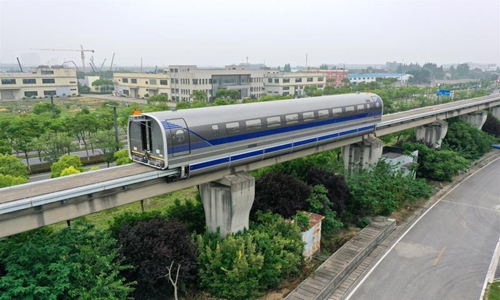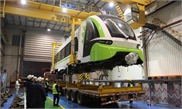SOURCE / INDUSTRIES
Breakthrough for China’s first 600 km/h high-speed maglev test vehicle

A prototype high-speed maglev test vehicle Photo: Courtesy of CRCC Qingdao Sifang Co
A prototype high-speed maglev test vehicle with a speed of 600 km/h, developed by CRCC Qingdao Sifang Co, successfully ran on the test line at Tongji University in Shanghai Sunday, an important breakthrough in China's high-speed maglev research and development.
Production of the prototype system is expected to begin at the end of 2020. The system will provide full high-speed maglev technology and engineering capability, bridging the gap between high-speed rail and air transportation, and meeting the travel needs of different groups.
In the project by the China Railway Rolling Stock Corporation (CRRC), with CRCC Qingdao Sifang Co responsible for the technology, more than 30 enterprises, colleges and universities, and scientific institutes have been involved in the research, which has seen a collaboration of domestic resources in the high-speed rail and maglev fields.
The ultimate aim is to master high-speed maglev core technology and develop the independent intellectual property rights for a 600 km/h hour high-speed maglev engineering system, eventually industrializing the technology.
The successful trial run marked a step forward from static to dynamic operation, obtained a large amount of key data and proved the key performance of the high-speed maglev system, providing technical support for the development and optimization of the follow-up high-speed maglev project test vehicle.
Since the launch of the project in July 2016, the research team has made numerous breakthroughs in key core technologies and successfully developed a test vehicle.
High-speed maglev fills the gap between high-speed rail and air transportation, and it can form a more logical, efficient, flexible and convenient multi-dimensional transportation architecture for aviation, high-speed rail, high-speed maglev and urban traffic speed gradients. This architecture can meet the travel needs of different groups, analysts said.
The news went viral as many netizens applauded this new breakthrough in the railway industry. Others, however, welcomed the news but remained skeptical about its possible high costs for construction and maintenance.
"When the high-speed trains were originally launched, there were people who were skeptical about the costs, but after years of operation, it's proven to be a great success," said Zhao Juan, research fellow with the China Railway Economic and Planning Research Institute.
"To industrialize maglev lines, China will need to create a network like that of high-speed trains today," she said.
In 2019, high-speed maglev, as a key frontier in science and technology, was listed in the outline on building China's strength in transportation. The development of a high-speed maglev transportation system with a speed of 600 km/h will be an important addition to China's high-speed transportation, analysts said.

